FIAT FULLBACK 2016 1.G Owners Manual
Manufacturer: FIAT, Model Year: 2016, Model line: FULLBACK, Model: FIAT FULLBACK 2016 1.GPages: 312, PDF Size: 13.67 MB
Page 131 of 312
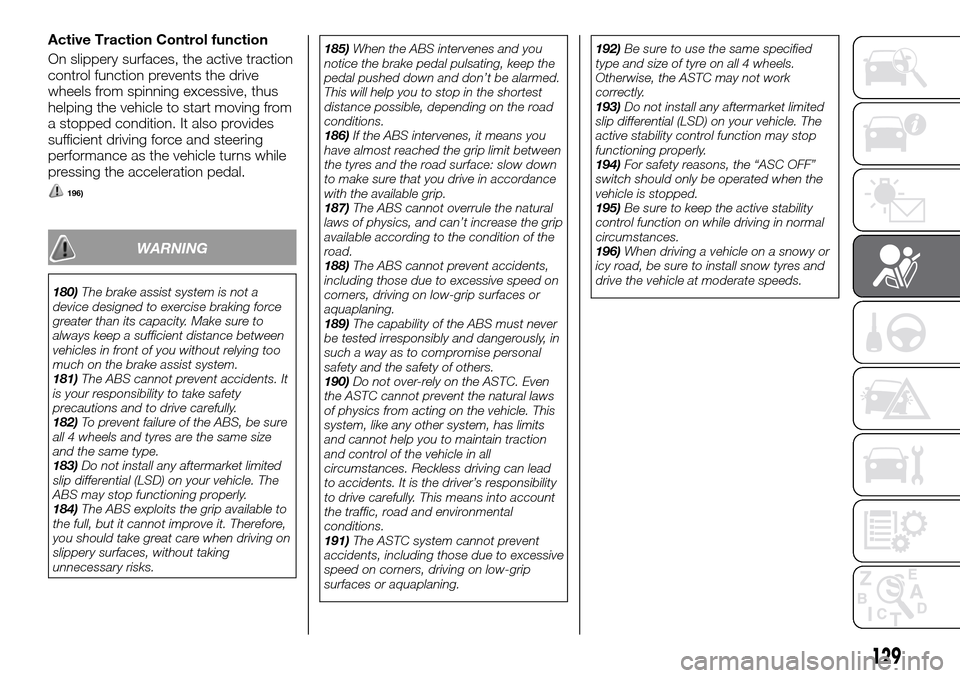
Active Traction Control function
On slippery surfaces, the active traction
control function prevents the drive
wheels from spinning excessive, thus
helping the vehicle to start moving from
a stopped condition. It also provides
sufficient driving force and steering
performance as the vehicle turns while
pressing the acceleration pedal.
196)
WARNING
180)The brake assist system is not a
device designed to exercise braking force
greater than its capacity. Make sure to
always keep a sufficient distance between
vehicles in front of you without relying too
much on the brake assist system.
181)The ABS cannot prevent accidents. It
is your responsibility to take safety
precautions and to drive carefully.
182)To prevent failure of the ABS, be sure
all 4 wheels and tyres are the same size
and the same type.
183)Do not install any aftermarket limited
slip differential (LSD) on your vehicle. The
ABS may stop functioning properly.
184)The ABS exploits the grip available to
the full, but it cannot improve it. Therefore,
you should take great care when driving on
slippery surfaces, without taking
unnecessary risks.185)When the ABS intervenes and you
notice the brake pedal pulsating, keep the
pedal pushed down and don’t be alarmed.
This will help you to stop in the shortest
distance possible, depending on the road
conditions.
186)If the ABS intervenes, it means you
have almost reached the grip limit between
the tyres and the road surface: slow down
to make sure that you drive in accordance
with the available grip.
187)The ABS cannot overrule the natural
laws of physics, and can’t increase the grip
available according to the condition of the
road.
188)The ABS cannot prevent accidents,
including those due to excessive speed on
corners, driving on low-grip surfaces or
aquaplaning.
189)The capability of the ABS must never
be tested irresponsibly and dangerously, in
such a way as to compromise personal
safety and the safety of others.
190)Do not over-rely on the ASTC. Even
the ASTC cannot prevent the natural laws
of physics from acting on the vehicle. This
system, like any other system, has limits
and cannot help you to maintain traction
and control of the vehicle in all
circumstances. Reckless driving can lead
to accidents. It is the driver’s responsibility
to drive carefully. This means into account
the traffic, road and environmental
conditions.
191)The ASTC system cannot prevent
accidents, including those due to excessive
speed on corners, driving on low-grip
surfaces or aquaplaning.192)Be sure to use the same specified
type and size of tyre on all 4 wheels.
Otherwise, the ASTC may not work
correctly.
193)Do not install any aftermarket limited
slip differential (LSD) on your vehicle. The
active stability control function may stop
functioning properly.
194)For safety reasons, the “ASC OFF”
switch should only be operated when the
vehicle is stopped.
195)Be sure to keep the active stability
control function on while driving in normal
circumstances.
196)When driving a vehicle on a snowy or
icy road, be sure to install snow tyres and
drive the vehicle at moderate speeds.
129
Page 132 of 312
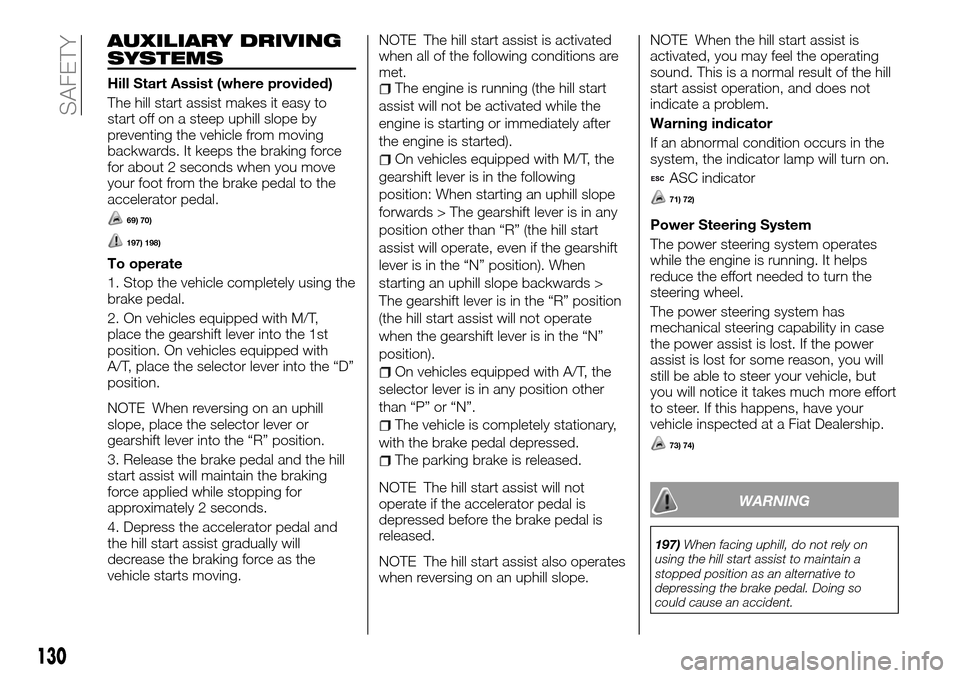
AUXILIARY DRIVING
SYSTEMS
Hill Start Assist (where provided)
The hill start assist makes it easy to
start off on a steep uphill slope by
preventing the vehicle from moving
backwards. It keeps the braking force
for about 2 seconds when you move
your foot from the brake pedal to the
accelerator pedal.
69) 70)
197) 198)
To operate
1. Stop the vehicle completely using the
brake pedal.
2. On vehicles equipped with M/T,
place the gearshift lever into the 1st
position. On vehicles equipped with
A/T, place the selector lever into the “D”
position.
NOTE When reversing on an uphill
slope, place the selector lever or
gearshift lever into the “R” position.
3. Release the brake pedal and the hill
start assist will maintain the braking
force applied while stopping for
approximately 2 seconds.
4. Depress the accelerator pedal and
the hill start assist gradually will
decrease the braking force as the
vehicle starts moving.NOTE The hill start assist is activated
when all of the following conditions are
met.
The engine is running (the hill start
assist will not be activated while the
engine is starting or immediately after
the engine is started).
On vehicles equipped with M/T, the
gearshift lever is in the following
position: When starting an uphill slope
forwards > The gearshift lever is in any
position other than “R” (the hill start
assist will operate, even if the gearshift
lever is in the “N” position). When
starting an uphill slope backwards >
The gearshift lever is in the “R” position
(the hill start assist will not operate
when the gearshift lever is in the “N”
position).
On vehicles equipped with A/T, the
selector lever is in any position other
than “P” or “N”.
The vehicle is completely stationary,
with the brake pedal depressed.
The parking brake is released.
NOTE The hill start assist will not
operate if the accelerator pedal is
depressed before the brake pedal is
released.
NOTE The hill start assist also operates
when reversing on an uphill slope.NOTE When the hill start assist is
activated, you may feel the operating
sound. This is a normal result of the hill
start assist operation, and does not
indicate a problem.
Warning indicator
If an abnormal condition occurs in the
system, the indicator lamp will turn on.
ASC indicator
71) 72)
Power Steering System
The power steering system operates
while the engine is running. It helps
reduce the effort needed to turn the
steering wheel.
The power steering system has
mechanical steering capability in case
the power assist is lost. If the power
assist is lost for some reason, you will
still be able to steer your vehicle, but
you will notice it takes much more effort
to steer. If this happens, have your
vehicle inspected at a Fiat Dealership.
73) 74)
WARNING
197)When facing uphill, do not rely on
using the hill start assist to maintain a
stopped position as an alternative to
depressing the brake pedal. Doing so
could cause an accident.
130
SAFETY
Page 133 of 312
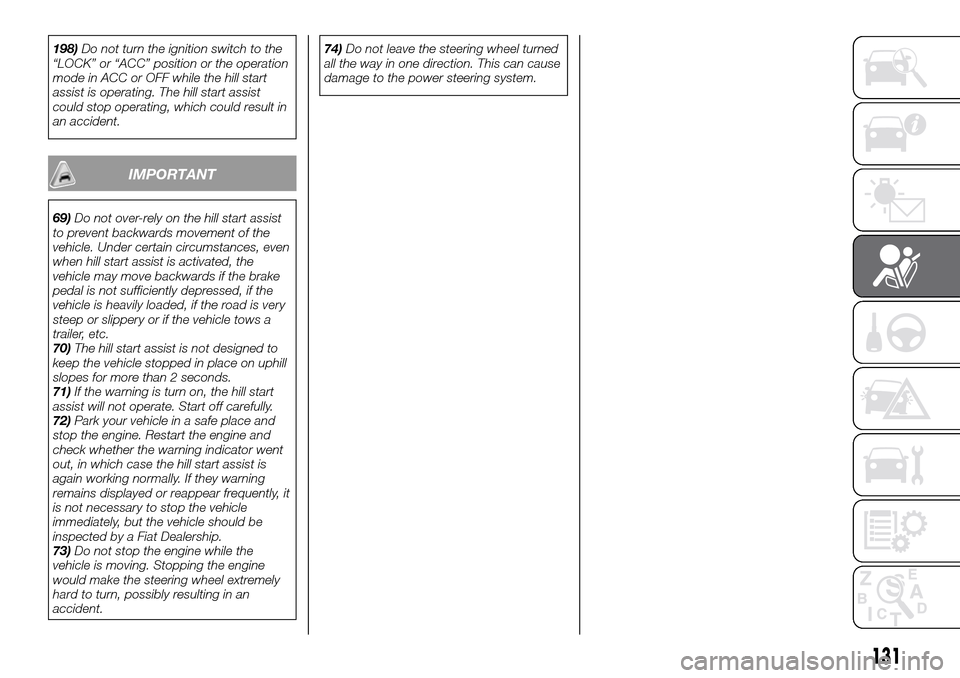
198)Do not turn the ignition switch to the
“LOCK” or “ACC” position or the operation
mode in ACC or OFF while the hill start
assist is operating. The hill start assist
could stop operating, which could result in
an accident.
IMPORTANT
69)Do not over-rely on the hill start assist
to prevent backwards movement of the
vehicle. Under certain circumstances, even
when hill start assist is activated, the
vehicle may move backwards if the brake
pedal is not sufficiently depressed, if the
vehicle is heavily loaded, if the road is very
steep or slippery or if the vehicle tows a
trailer, etc.
70)The hill start assist is not designed to
keep the vehicle stopped in place on uphill
slopes for more than 2 seconds.
71)If the warning is turn on, the hill start
assist will not operate. Start off carefully.
72)Park your vehicle in a safe place and
stop the engine. Restart the engine and
check whether the warning indicator went
out, in which case the hill start assist is
again working normally. If they warning
remains displayed or reappear frequently, it
is not necessary to stop the vehicle
immediately, but the vehicle should be
inspected by a Fiat Dealership.
73)Do not stop the engine while the
vehicle is moving. Stopping the engine
would make the steering wheel extremely
hard to turn, possibly resulting in an
accident.74)Do not leave the steering wheel turned
all the way in one direction. This can cause
damage to the power steering system.
131
Page 134 of 312
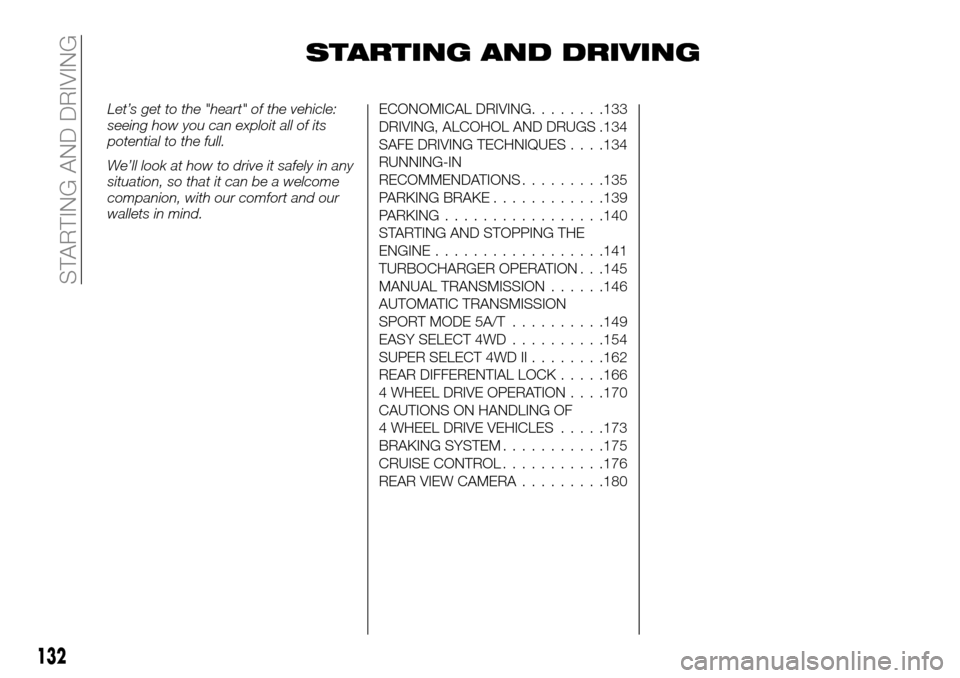
STARTING AND DRIVING
Let’s get to the "heart" of the vehicle:
seeing how you can exploit all of its
potential to the full.
We’ll look at how to drive it safely in any
situation, so that it can be a welcome
companion, with our comfort and our
wallets in mind.ECONOMICAL DRIVING........133
DRIVING, ALCOHOL AND DRUGS .134
SAFE DRIVING TECHNIQUES. . . .134
RUNNING-IN
RECOMMENDATIONS.........135
PARKING BRAKE............139
PARKING.................140
STARTING AND STOPPING THE
ENGINE..................141
TURBOCHARGER OPERATION . . .145
MANUAL TRANSMISSION......146
AUTOMATIC TRANSMISSION
SPORT MODE 5A/T..........149
EASY SELECT 4WD..........154
SUPER SELECT 4WD II........162
REAR DIFFERENTIAL LOCK.....166
4 WHEEL DRIVE OPERATION. . . .170
CAUTIONS ON HANDLING OF
4 WHEEL DRIVE VEHICLES.....173
BRAKING SYSTEM...........175
CRUISE CONTROL...........176
REAR VIEW CAMERA.........180
132
STARTING AND DRIVING
Page 135 of 312
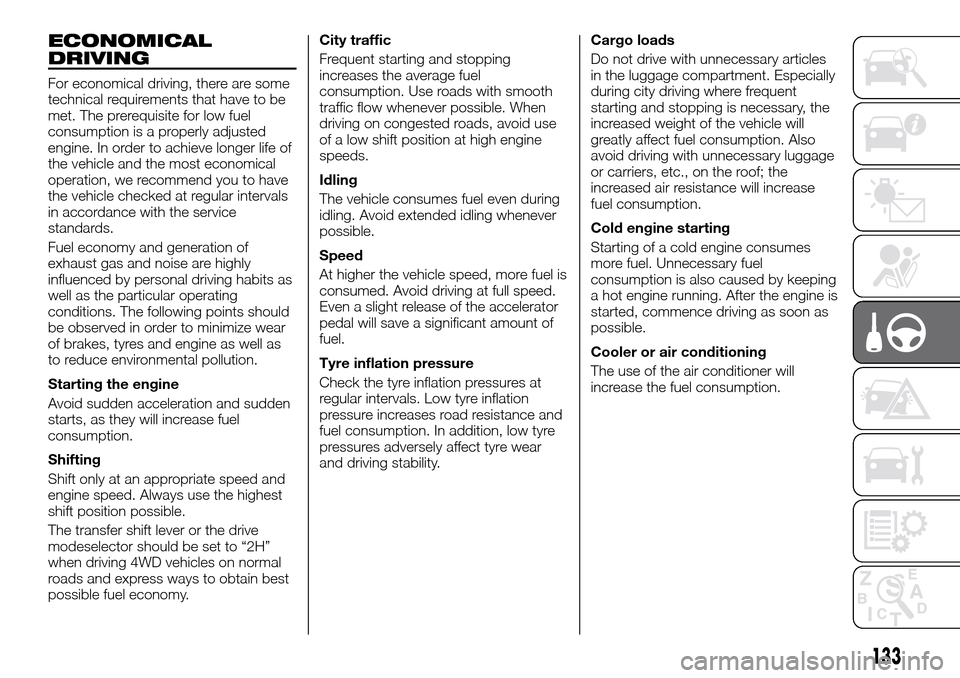
ECONOMICAL
DRIVING
For economical driving, there are some
technical requirements that have to be
met. The prerequisite for low fuel
consumption is a properly adjusted
engine. In order to achieve longer life of
the vehicle and the most economical
operation, we recommend you to have
the vehicle checked at regular intervals
in accordance with the service
standards.
Fuel economy and generation of
exhaust gas and noise are highly
influenced by personal driving habits as
well as the particular operating
conditions. The following points should
be observed in order to minimize wear
of brakes, tyres and engine as well as
to reduce environmental pollution.
Starting the engine
Avoid sudden acceleration and sudden
starts, as they will increase fuel
consumption.
Shifting
Shift only at an appropriate speed and
engine speed. Always use the highest
shift position possible.
The transfer shift lever or the drive
modeselector should be set to “2H”
when driving 4WD vehicles on normal
roads and express ways to obtain best
possible fuel economy.City traffic
Frequent starting and stopping
increases the average fuel
consumption. Use roads with smooth
traffic flow whenever possible. When
driving on congested roads, avoid use
of a low shift position at high engine
speeds.
Idling
The vehicle consumes fuel even during
idling. Avoid extended idling whenever
possible.
Speed
At higher the vehicle speed, more fuel is
consumed. Avoid driving at full speed.
Even a slight release of the accelerator
pedal will save a significant amount of
fuel.
Tyre inflation pressure
Check the tyre inflation pressures at
regular intervals. Low tyre inflation
pressure increases road resistance and
fuel consumption. In addition, low tyre
pressures adversely affect tyre wear
and driving stability.Cargo loads
Do not drive with unnecessary articles
in the luggage compartment. Especially
during city driving where frequent
starting and stopping is necessary, the
increased weight of the vehicle will
greatly affect fuel consumption. Also
avoid driving with unnecessary luggage
or carriers, etc., on the roof; the
increased air resistance will increase
fuel consumption.
Cold engine starting
Starting of a cold engine consumes
more fuel. Unnecessary fuel
consumption is also caused by keeping
a hot engine running. After the engine is
started, commence driving as soon as
possible.
Cooler or air conditioning
The use of the air conditioner will
increase the fuel consumption.
133
Page 136 of 312
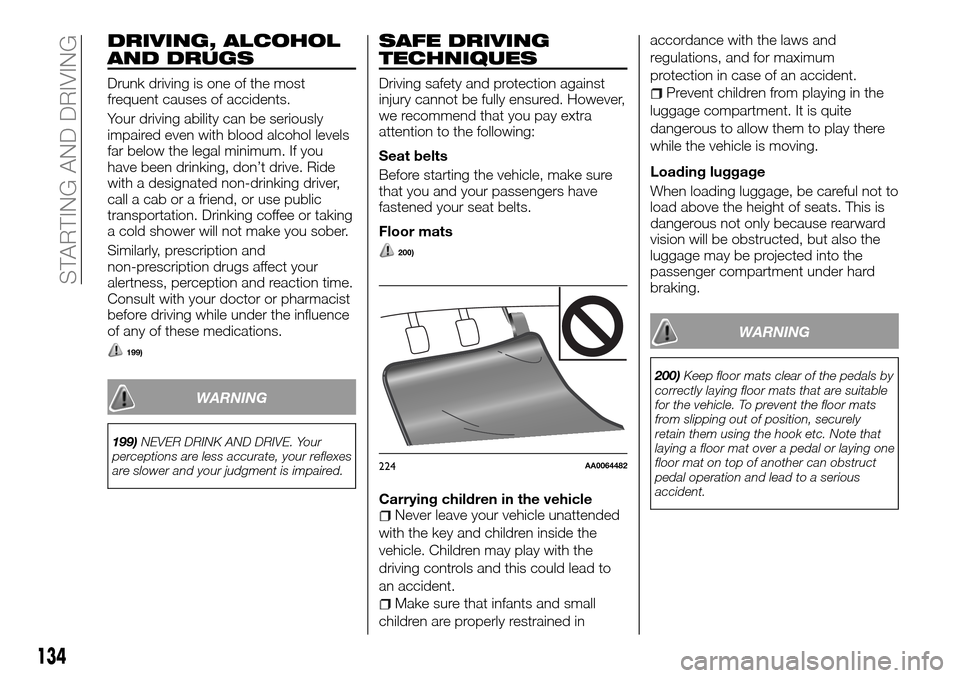
DRIVING, ALCOHOL
AND DRUGS
Drunk driving is one of the most
frequent causes of accidents.
Your driving ability can be seriously
impaired even with blood alcohol levels
far below the legal minimum. If you
have been drinking, don’t drive. Ride
with a designated non-drinking driver,
call a cab or a friend, or use public
transportation. Drinking coffee or taking
a cold shower will not make you sober.
Similarly, prescription and
non-prescription drugs affect your
alertness, perception and reaction time.
Consult with your doctor or pharmacist
before driving while under the influence
of any of these medications.
199)
WARNING
199)NEVER DRINK AND DRIVE. Your
perceptions are less accurate, your reflexes
are slower and your judgment is impaired.
SAFE DRIVING
TECHNIQUES
Driving safety and protection against
injury cannot be fully ensured. However,
we recommend that you pay extra
attention to the following:
Seat belts
Before starting the vehicle, make sure
that you and your passengers have
fastened your seat belts.
Floor mats
200)
Carrying children in the vehicleNever leave your vehicle unattended
with the key and children inside the
vehicle. Children may play with the
driving controls and this could lead to
an accident.
Make sure that infants and small
children are properly restrained inaccordance with the laws and
regulations, and for maximum
protection in case of an accident.
Prevent children from playing in the
luggage compartment. It is quite
dangerous to allow them to play there
while the vehicle is moving.
Loading luggage
When loading luggage, be careful not to
load above the height of seats. This is
dangerous not only because rearward
vision will be obstructed, but also the
luggage may be projected into the
passenger compartment under hard
braking.
WARNING
200)Keep floor mats clear of the pedals by
correctly laying floor mats that are suitable
for the vehicle. To prevent the floor mats
from slipping out of position, securely
retain them using the hook etc. Note that
laying a floor mat over a pedal or laying one
floor mat on top of another can obstruct
pedal operation and lead to a serious
accident.
224AA0064482
134
STARTING AND DRIVING
Page 137 of 312
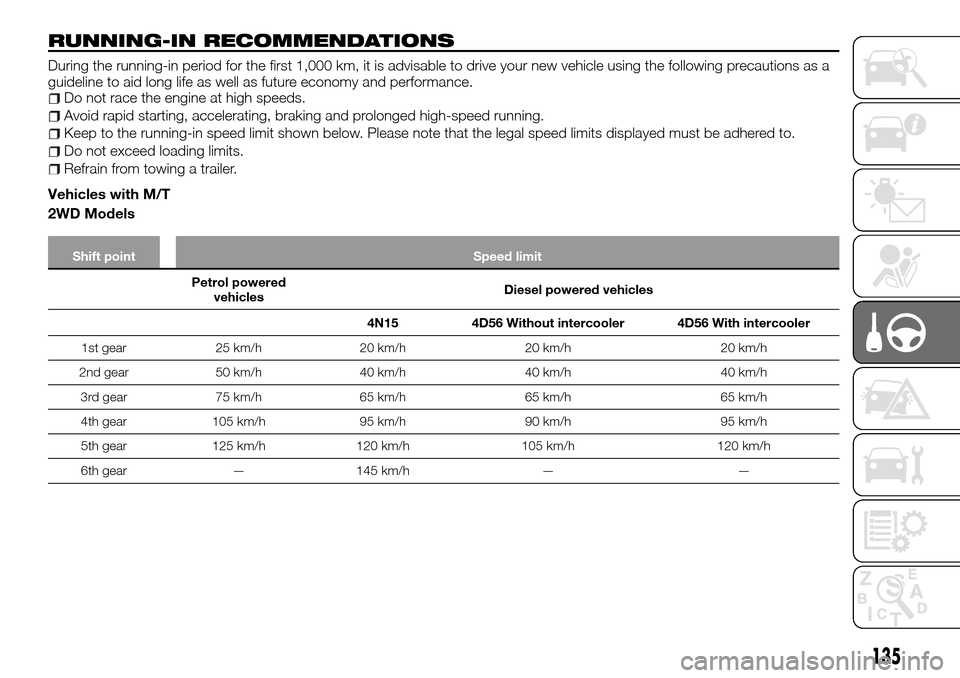
RUNNING-IN RECOMMENDATIONS
During the running-in period for the first 1,000 km, it is advisable to drive your new vehicle using the following precautions as a
guideline to aid long life as well as future economy and performance.
Do not race the engine at high speeds.
Avoid rapid starting, accelerating, braking and prolonged high-speed running.
Keep to the running-in speed limit shown below. Please note that the legal speed limits displayed must be adhered to.
Do not exceed loading limits.
Refrain from towing a trailer.
Vehicles with M/T
2WD Models
Shift point Speed limit
Petrol powered
vehiclesDiesel powered vehicles
4N15 4D56 Without intercooler 4D56 With intercooler
1st gear 25 km/h 20 km/h 20 km/h 20 km/h
2nd gear 50 km/h 40 km/h 40 km/h 40 km/h
3rd gear 75 km/h 65 km/h 65 km/h 65 km/h
4th gear 105 km/h 95 km/h 90 km/h 95 km/h
5th gear 125 km/h 120 km/h 105 km/h 120 km/h
6th gear — 145 km/h — —
135
Page 138 of 312
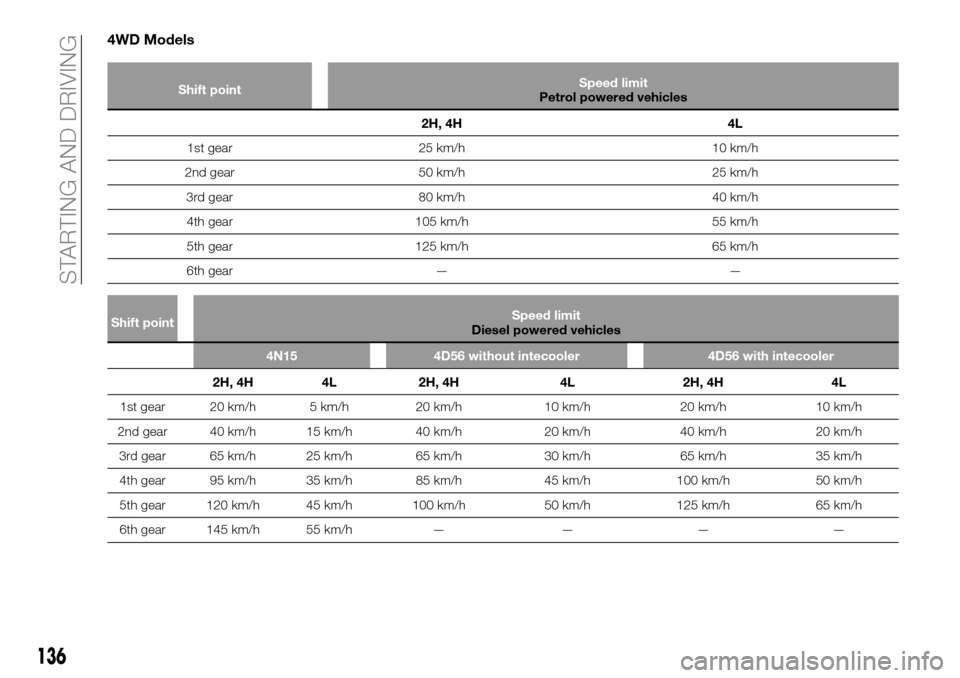
4WD Models
Shift pointSpeed limitPetrol powered vehicles
2H, 4H 4L
1st gear 25 km/h 10 km/h
2nd gear 50 km/h 25 km/h
3rd gear 80 km/h 40 km/h
4th gear 105 km/h 55 km/h
5th gear 125 km/h 65 km/h
6th gear — —
Shift pointSpeed limitDiesel powered vehicles
4N15 4D56 without intecooler 4D56 with intecooler
2H, 4H 4L 2H, 4H 4L 2H, 4H 4L
1st gear 20 km/h 5 km/h 20 km/h 10 km/h 20 km/h 10 km/h
2nd gear 40 km/h 15 km/h 40 km/h 20 km/h 40 km/h 20 km/h
3rd gear 65 km/h 25 km/h 65 km/h 30 km/h 65 km/h 35 km/h
4th gear 95 km/h 35 km/h 85 km/h 45 km/h 100 km/h 50 km/h
5th gear 120 km/h 45 km/h 100 km/h 50 km/h 125 km/h 65 km/h
6th gear 145 km/h 55 km/h — — — —
136
STARTING AND DRIVING
Page 139 of 312
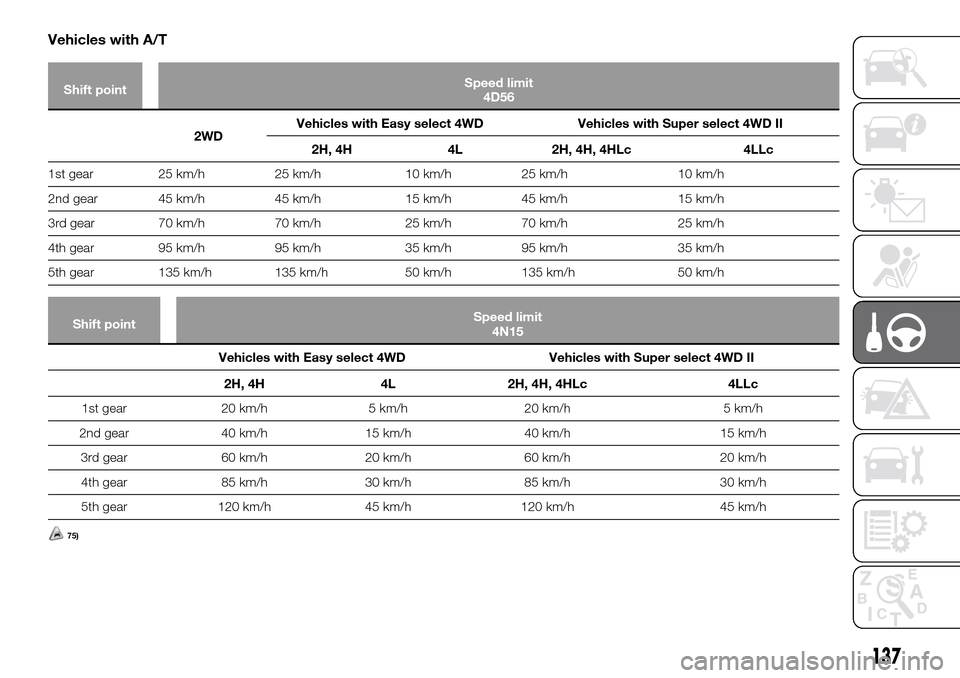
Vehicles with A/T
Shift pointSpeed limit
4D56
2WDVehicles with Easy select 4WD Vehicles with Super select 4WD II
2H, 4H 4L 2H, 4H, 4HLc 4LLc
1st gear 25 km/h 25 km/h 10 km/h 25 km/h 10 km/h
2nd gear 45 km/h 45 km/h 15 km/h 45 km/h 15 km/h
3rd gear 70 km/h 70 km/h 25 km/h 70 km/h 25 km/h
4th gear 95 km/h 95 km/h 35 km/h 95 km/h 35 km/h
5th gear 135 km/h 135 km/h 50 km/h 135 km/h 50 km/h
Shift pointSpeed limit
4N15
Vehicles with Easy select 4WD Vehicles with Super select 4WD II
2H, 4H 4L 2H, 4H, 4HLc 4LLc
1st gear 20 km/h 5 km/h 20 km/h 5 km/h
2nd gear 40 km/h 15 km/h 40 km/h 15 km/h
3rd gear 60 km/h 20 km/h 60 km/h 20 km/h
4th gear 85 km/h 30 km/h 85 km/h 30 km/h
5th gear 120 km/h 45 km/h 120 km/h 45 km/h
75)
137
Page 140 of 312
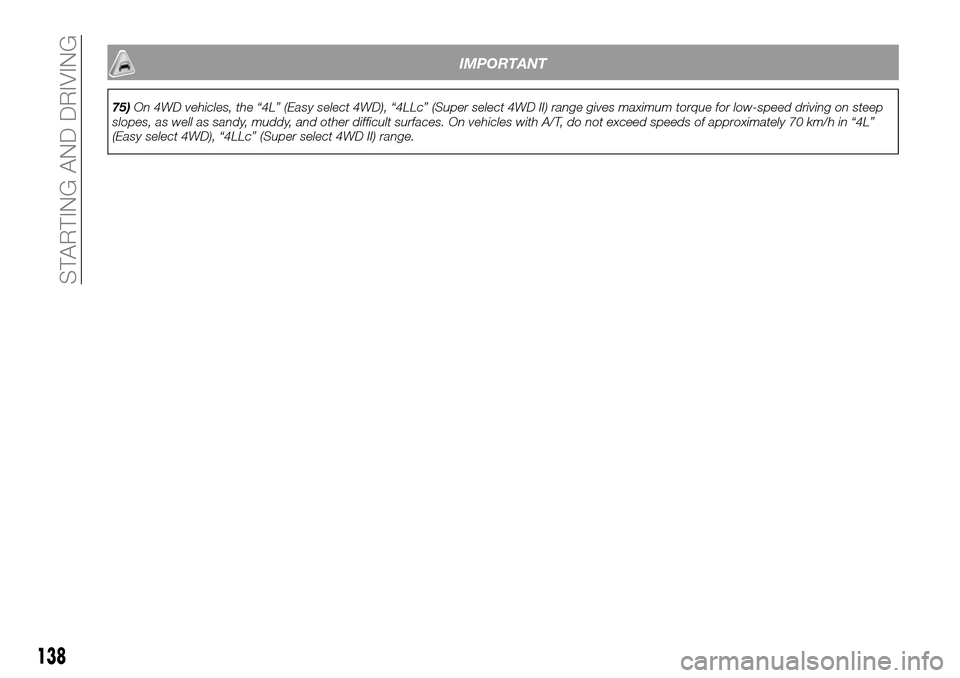
IMPORTANT
75)On 4WD vehicles, the “4L” (Easy select 4WD), “4LLc” (Super select 4WD II) range gives maximum torque for low-speed driving on steep
slopes, as well as sandy, muddy, and other difficult surfaces. On vehicles with A/T, do not exceed speeds of approximately 70 km/h in “4L”
(Easy select 4WD), “4LLc” (Super select 4WD II) range.
138
STARTING AND DRIVING